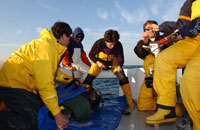There’s a long
list of things that have to go right to tag a giant bluefin tuna. Here’s an abbreviated version.
To tag a giant bluefin tuna you have to:
1.) Obtain
research permits, program and prepare the electronic tags, and pack a lot of
gear (don't forget anything!!!).
2.) Travel
to a remote corner of Nova Scotia.
 |
| Autumn colors on Cape Breton Island, Nova Scotia. photo: E. Estess |
3.) Wait,
and wait, and wait for the weather to clear up. We were only able to fish 7
days out of 3 weeks this October due to weather!
4.) Make
sure your tagging boat motor is working.
5.) Find
and catch large mackerel for bait.
6.) Search
for a school of bluefin tuna (this can take hours/days).
 |
| Diving gannets and busting bluefin. photo: E. Estess |
7.) Get
a bluefin to bite the bait. Bluefin are notoriously picky about what they will
bite. Last week we had a school of giant bluefin jumping through our mackerel baits
without a single hookup!
 |
| A bluefin nails the bait! photo: E. Estess |
8.) Make
sure the circle hook sets in the corner of the tuna’s mouth.
9.) Fight
the fish to the stern without pulling so hard that you
break the straining monofilament or bend the small metal hook.
 |
| Lloyd MacInnes and Dennis Cameron work together to angle in a large bluefin for the tagging team. photo: E. Estess |
10.) Guide the head of the tuna to the back
door of the tagging boat. This is one of the
hardest steps as the tuna can easily shake its head and pull the hook, particularly when the seas are rough.
11.) Use 5 people to pull the (up to 1,600lb)
animal through the back door of the tagging
boat onto a padded surgical mat.
12.) Place a hose into the tuna’s mouth to
irrigate the gills with oxygen rich seawater and place fabric over the animal’s
eye to reduce stress.
 |
| An eye cover and irrigation hose help keep the bluefin calm and safe on deck. Photo: R. Schallert |
13.) Remove the hook from the corner of the mouth.
14.) Measure the length of the fish. This
length measurement can be converted to an
estimate of the fish’s weight at a later time.
15.) Insert sterilized titanium darts into
precise locations along the tuna’s back to anchor
acoustic and satellite tags securely to the fish. If done correctly, the acoustic tags will last for up to 5 years and
the satellite tags will automatically detach
from the animal after 1 year. Note: All tagging and handling procedures are conducted under the strictest
animal care protocols.
 |
| Dr. Steve Wilson places a satellite tag into the dorsal muscle of a large Atlantic bluefin. Photo: E. Estess |
16.) Insert a conventional/spaghetti tag with
the phone numbers to call in case the fish is
recaptured by a commercial fisherman.
17.) Take a small (pencil eraser-sized) clip
of the tuna’s fin to use for DNA sequencing. This will allow us to understand if the
animal is from the eastern or western
Atlantic population of bluefin.
18.) Lift and rotate the surgical mat to point
the tuna’s head out the door (easier said than done!).
 |
| The Tag-A-Giant team lifts a giant bluefin to release it back into the Gulf of St. Lawrence. Photo: R. Schallert |
19.) Guide the tuna out the door and watch it
kick away into the deep blue of the Gulf of St. Lawrence.
20.) Exchange high 5’s with the team!
The weeks of
preparation and decades of expertise between the fishermen and researchers paid
off and we were able to tag and release two giant bluefin on this trip. Our
past results have shown that a majority of these tunas swim south from the
foraging grounds in Nova Scotia to the Gulf of Mexico to spawn, and a small
percentage swim across the Atlantic into the Mediterranean Sea for lesser-known
reasons. Only through long-term tagging
studies like this will we be able to understand tuna migration and life history
in order to effectively model population sizes for stock assessment and
sustainable management of this species.
Follow this link
to the recent publication of our 8-years of tagging effort in Nova Scotia:
http://www.tunaresearch.org/reprints/Wilson_et_al_2015.pdf








